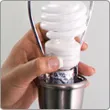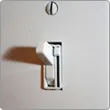Learn about CFLs

How Do CFLs Work?
CFLs produce light differently than incandescent bulbs. In an incandescent, electric current runs through a wire filament and heats the filament until it starts to glow. In a CFL, an electric current is driven through a tube containing argon and a small amount of mercury vapor. This generates invisible ultraviolet light that excites a fluorescent coating (called phosphor) on the inside of the tube, which then emits visible light.
CFLs need a little more energy when they are first turned on, but once the electricity starts moving, CFLs use about 70% less energy than incandescent bulbs. A CFL’s ballast helps "kick start" the CFL and then regulates the current once the electricity starts flowing.
This entire process typically takes 30 seconds to 3 minutes to complete, which is why CFLs take longer than other lights to become fully lit. CFLs with decorative covers like globe or reflector shapes have a unique design challenge that results in the tradeoff of a slower warm up time, which is why these CFLs take longer than bare spirals to reach full brightness.
Older CFLs used large and heavy magnetic ballasts that caused a buzzing noise in some bulbs. Most CFLs today — and all ENERGY STAR certified CFLs — use electronic ballasts, which do not buzz or hum.
Purchasing Tips
- Look for the ENERGY STAR label
- Decide how much light you need
- Remember that Lumens measure brightness, not Watts
- Learn more about brightness.
- Check the package for the bulb’s recommended use
- New bulbs are specially designed for certain applications, let the package be your guide!
- Check out our Guide to ENERGY STAR packaging
- Think about the mood you want from your light
- Choose a light color from warm to cool for your needs.
- Learn more about color and mood.
Check out the ENERGY STAR Light Bulb Purchasing Guide (PDF, 1.49 MB)
How Do I Get the Most from my CFLs?

Do the twist.
Screw in your CFL by holding the ballast (the white plastic part), NOT the glass tubing.

Don’t flip too fast.
You’ll maximize the lifetime savings and effectiveness of your CFLs by keeping them on for 15 minutes or more at a time.

Choose 3 for 3.
Only use bulbs labeled as three-way on three-way sockets.

Don’t dim a non-dimmable.
Only use bulbs labeled as dimmable on dimmer switches.

Check your controls.
Most photocells, motion sensors and electric timers are not designed to work with CFLs. Always check with the manufacturer of the control for compatibility.

Give them air.
CFLs are sensitive to extreme temperatures, so place your CFLs in open fixtures indoors. Using them in enclosed fixtures indoors can create a hot environment that reduces the lifetime of your bulbs. Note that covered reflectors are best used in recessed cans.

Protect them outside.
Protect bulbs from the elements by placing them inside enclosed fixtures outdoors. For colder climates, look at the packaging for optimal operating temperatures.
